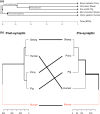Recognising the potential of large animals for modelling neuromuscular junction physiology and disease
- PMID: 36056593
- PMCID: PMC9558152
- DOI: 10.1111/joa.13749
Recognising the potential of large animals for modelling neuromuscular junction physiology and disease
Abstract
The aetiology and pathophysiology of many diseases of the motor unit remain poorly understood and the role of the neuromuscular junction (NMJ) in this group of disorders is particularly overlooked, especially in humans, when these diseases are comparatively rare. However, elucidating the development, function and degeneration of the NMJ is essential to uncover its contribution to neuromuscular disorders, and to explore potential therapeutic avenues to treat these devastating diseases. Until now, an understanding of the role of the NMJ in disease pathogenesis has been hindered by inherent differences between rodent and human NMJs: stark contrasts in body size and corresponding differences in associated axon length underpin some of the translational issues in animal models of neuromuscular disease. Comparative studies in large mammalian models, including examination of naturally occurring, highly prevalent animal diseases and evaluation of their treatment, might provide more relevant insights into the pathogenesis and therapy of equivalent human diseases. This review argues that large animal models offer great potential to enhance our understanding of the neuromuscular system in health and disease, and in particular, when dealing with diseases for which nerve length dependency might underly the pathogenesis.
Keywords: NMDs; NMJ disorders; large animals; peripheral neuropathy.
© 2022 The Authors. Journal of Anatomy published by John Wiley & Sons Ltd on behalf of Anatomical Society.
Figures




Similar articles
-
A method to identify, dissect and stain equine neuromuscular junctions for morphological analysis.J Anat. 2022 Nov;241(5):1133-1147. doi: 10.1111/joa.13747. Epub 2022 Sep 10. J Anat. 2022. PMID: 36087283 Free PMC article.
-
Comparative anatomy of the mammalian neuromuscular junction.J Anat. 2020 Nov;237(5):827-836. doi: 10.1111/joa.13260. Epub 2020 Jun 23. J Anat. 2020. PMID: 32573802 Free PMC article.
-
Axonal degeneration, distal collateral branching and neuromuscular junction architecture alterations occur prior to symptom onset in the SOD1(G93A) mouse model of amyotrophic lateral sclerosis.J Chem Neuroanat. 2016 Oct;76(Pt A):35-47. doi: 10.1016/j.jchemneu.2016.03.003. Epub 2016 Mar 30. J Chem Neuroanat. 2016. PMID: 27038603
-
Molecular architecture of the neuromuscular junction.Muscle Nerve. 2006 Apr;33(4):445-61. doi: 10.1002/mus.20440. Muscle Nerve. 2006. PMID: 16228970 Review.
-
The Neuromuscular Junction: Roles in Aging and Neuromuscular Disease.Int J Mol Sci. 2021 Jul 28;22(15):8058. doi: 10.3390/ijms22158058. Int J Mol Sci. 2021. PMID: 34360831 Free PMC article. Review.
Cited by
-
Rapid iPSC-derived neuromuscular junction model uncovers motor neuron dominance in amyotrophic lateral sclerosis cytopathy.Cell Death Discov. 2025 Jan 25;11(1):23. doi: 10.1038/s41420-025-02302-5. Cell Death Discov. 2025. PMID: 39863573 Free PMC article.
-
Editorial: Peripheral nerve anatomy in health and disease.J Anat. 2022 Nov;241(5):1083-1088. doi: 10.1111/joa.13746. J Anat. 2022. PMID: 36226698 Free PMC article. No abstract available.
-
From in vivo models to in vitro bioengineered neuromuscular junctions for the study of Charcot-Marie-Tooth disease.J Tissue Eng. 2025 Mar 12;16:20417314241310508. doi: 10.1177/20417314241310508. eCollection 2025 Jan-Dec. J Tissue Eng. 2025. PMID: 40078221 Free PMC article. Review.
-
A method to identify, dissect and stain equine neuromuscular junctions for morphological analysis.J Anat. 2022 Nov;241(5):1133-1147. doi: 10.1111/joa.13747. Epub 2022 Sep 10. J Anat. 2022. PMID: 36087283 Free PMC article.
-
Advancements in 2D and 3D In Vitro Models for Studying Neuromuscular Diseases.Int J Mol Sci. 2023 Nov 30;24(23):17006. doi: 10.3390/ijms242317006. Int J Mol Sci. 2023. PMID: 38069329 Free PMC article. Review.
References
-
- Banfield, J. , Lisak, R. , Omar, A. , Domingos, W. , Fiaschitello, A. , Morales‐Gomez, A. et al. (2019) Investigating the risk of equine motor neuron disease in a Brazilian stable and successful intervention. Journal of Equine Veterinary Science, 77, 132–138. 10.1016/j.jevs.2019.02.024 - DOI - PubMed
Publication types
MeSH terms
Grants and funding
LinkOut - more resources
Full Text Sources

